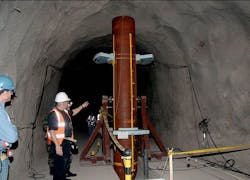Soon after Iran deal, Air Force looks for new ways to find and attack deeply buried targets
Officials of the Air Force Research Laboratory's Information Directorate in Rome, N.Y., issued a broad agency announcement Tuesday (BAA-AFRL-RIK-2015-0017) for the Super Hard and Deeply Buried Facility Identification and Characterization (SHDBFIC) project, which seeks technologies for finding and classifying deeply buried targets.
This solicitation comes less than a week after announcement of a nuclear weapons negotiation with Iran that seeks to prevent that country from developing nuclear weapons in a network of buried, hardened, and geographically scattered research facilities.
The Air Force Research Lab's Munitions Directorate has conducted a significant amount of work to neutralize hard and deeply buried targets, yet scientists at the Information Directorate want a better understanding of how to identify, locate, and characterize these kinds of facilities. Work may include the integration of existing technologies.
Related: Guidance and control for bunker-busting munitions
The goal of this solicitation is to evaluate new sources for hard and deeply buried underground testing, including technologies to conceal facilities from reconnaissance and unauthorized access. The idea is to enhance warfighter capabilities beyond what today is considered satisfactory. This effort will conduct underground facility research.
story continues below
The project should enable military experts to simulate and gather data against a wide array of targets and scenarios involving hard and deeply buried facilities, and realistically emulate the sensor signatures of super hard deeply buried facilities used for nuclear processing, biological agent engineering, and chemical production.
In addition, the effort seeks new ways to detect emerging cyber warfare and cyber security capabilities related to hard deeply buried facilities. Technology innovations that deliver new or improved operational capabilities are of high interest.
The SHDBFIC project focuses on two areas: characteristics gathering and signature analysis. Characteristics gathering involves new information collection and surveillance techniques for hard and deeply buried targets and how they might influence existing techniques, tactics, and procedures.
Signature analysis, meanwhile, involves the differences between the sensor signatures of underground facilities and above-ground traditional networked facilities, and how to simulate and analyze the electromagnetic emissions of hard and deeply buried targets.
Total funding for this project will be about $9.7 million over three years. Companies interested should send white papers no later than 28 Sept. 2015 by email to the Air Force's Capt. Richard Newkirk at [email protected], or by post to AFRL/RITF, 525 Brooks Road, Rome NY 13441-4505, and reference BAA-AFRL-RIK-2015-0017.
For technical questions contact Capt. Richard Newkirk by email at [email protected], or by phone at 518-275-3355. Direct contracting questions to Gail Marsh by email at [email protected], or by phone at 315-330-7518.
More information is online at https://www.fbo.gov/spg/USAF/AFMC/AFRLRRS/BAA-AFRL-RIK-2015-0017/listing.html.

